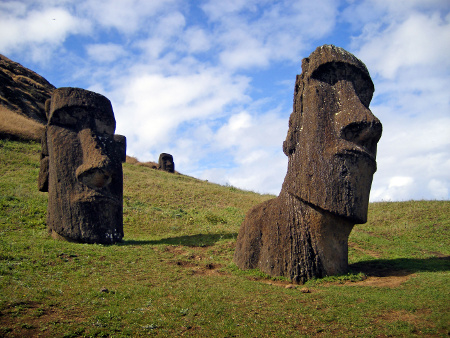Rapa Nui
Recently I have been reading Collapse by Jared Diamond. I remember reading books by Heinberg, limits to growth, etc ... and we have a chapter that tells the story of Easter Island which has impressed me. There are shocking analogies with present day. Clearly, there are other collapses like the Roman civilization that perhaps look closer. But for me, the collapse in this small, isolated Pacific island evokes me the worst fears. As these people ignored the clear signs of environmental degradation of their land.
Easter Island was colonized possibly around 900 AD. The population in the period before the arrival of Europeans ranged from 6,000 to 30,000 inhabitants. The island was slowly colonized, is famous for it's legendary statues, Moai, ranging in weight to about 90tn, which is essential to keep in mind to understand the history of the island, representing their ancestors. The island was divided into 12 clans, and of course the largest Moai, meant the most glorious ancestor. At first inhabitants occupied the areas closest to the coast, and slowly entering itself on higher grounds.
When Europeans arrived, they found a deforested island, the highest plants barely exceeding 2 meters height. But it was that way before. In fact archaeologists found seeds of a larger variant of the Chilean palm. Recent studies by Catherine Orliac and others found about another 21 plants, mostly extinct trees, studying the fossil traces of ash. These trees were used for canoes, firewood, houses, fruit, etc.. The island was home to at least six species of birds on the island, and about 25 of seabirds nesting in it. These six species disappeared, of the 25 seabirds, 24 stopped nesting on the same island, and only 9 continued nesting on nearby islets. The palms became extinct around 1400, the rest of the trees no later than 1640. Unable to continue making canoes, ended in further pressure the island's resources, depleting shellfish and coastal fishes. Losing the forest eroded the soil that was degraded causing diminishing crops.
All this degradation caused famines, riots, there was indeed a coup in about 1680, in which the military exterminated the nobility, and rejected the previous religious beliefs. Cannibalism appeared. When Europeans reached the island is was wasteland, the people malnourished, the Moai fallen, as they were knocked because of internal conflicts.
Many people wonder, why they didn't noticed it? What were they thinking when they cutted down the last tree? And when the last of the native birds was gone? No, they apparently didn't. There are many reasons. But a very basic one is that "their economy" was growing. The moai were getting bigger. We find it very easy to notice, afterword of course, while the process of collapse develops, not being instant and the requirement of changing ancestral behavior patterns complicates it.
Note: Quick translation of the original in spanish
